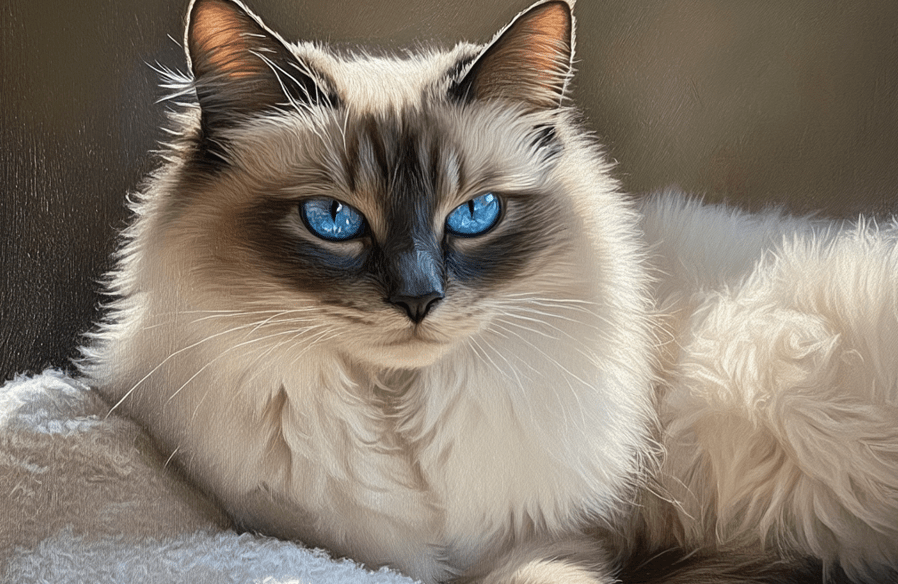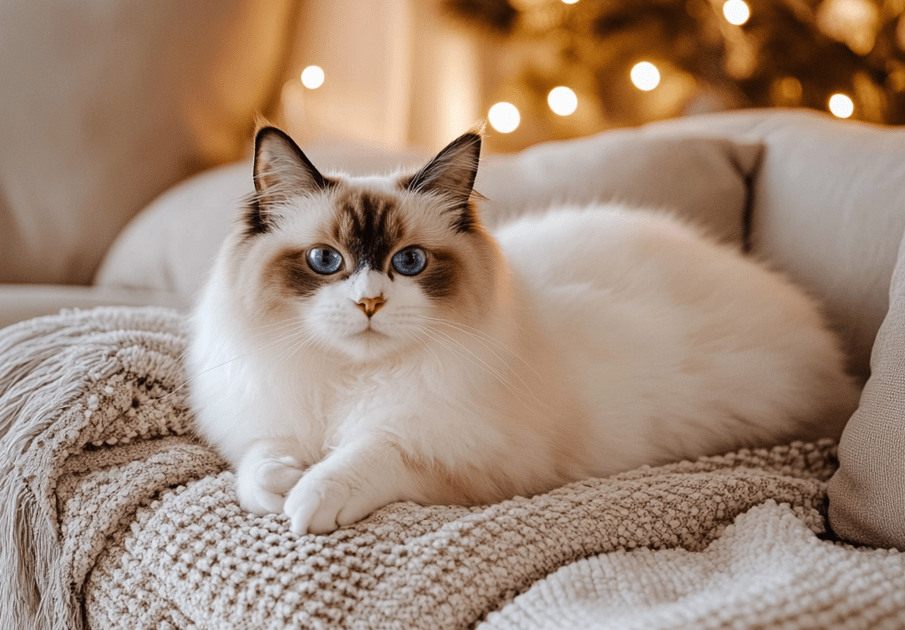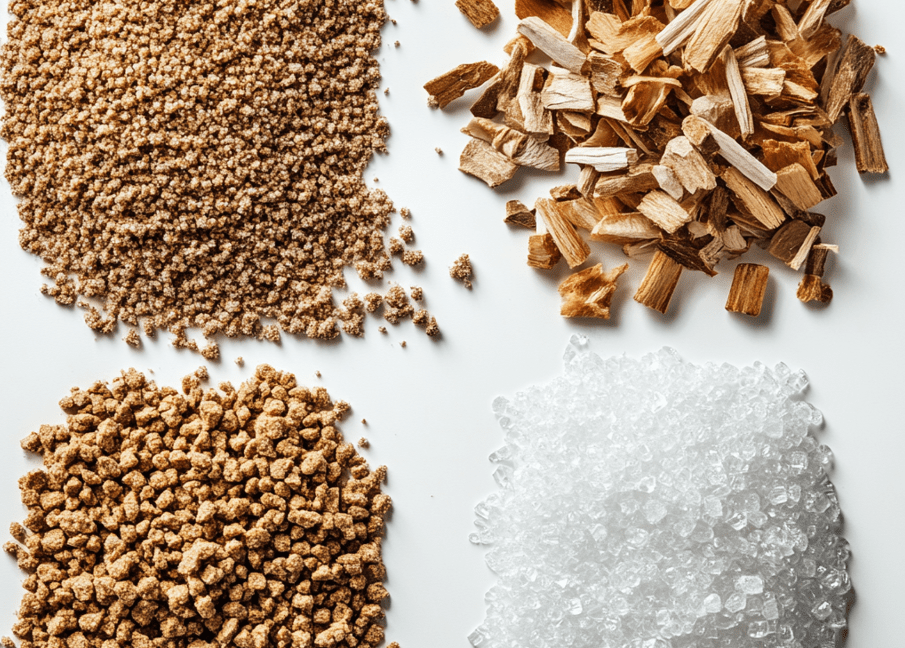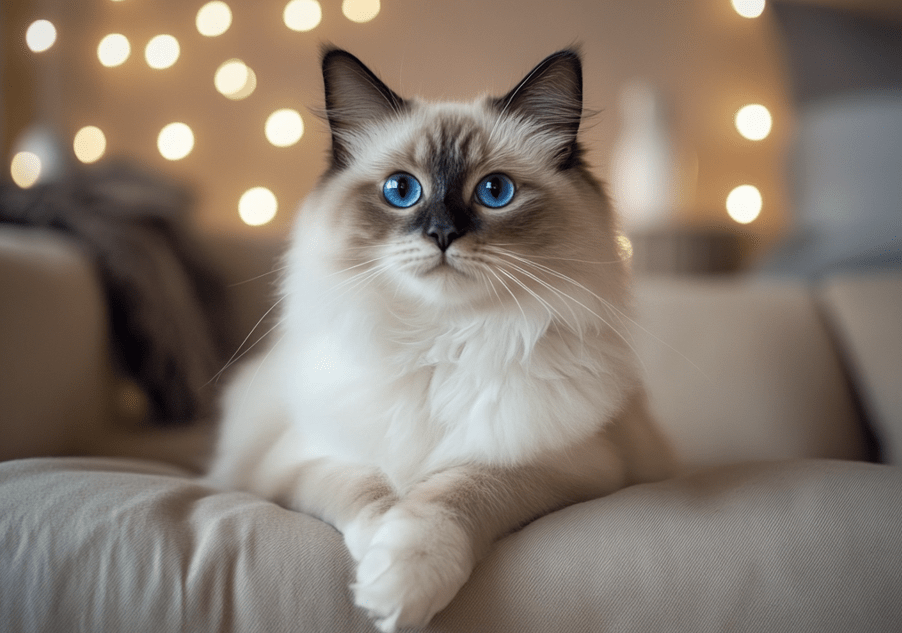
People commonly know Ragdoll cats because of their tender nature. Ragdolls attract many pet owners because of their relaxing disposition, caring personality, and easygoing nature. Typically, the weight limit for male Ragdoll cats reaches 20 pounds, whereas the weight range for female cats stops at 15 pounds but starts from 10 pounds. Ragdoll cats need straightforward care for their well-being and happiness, although they require minimal maintenance. In this article, we will examine the essential points of caring for Ragdoll cats through exploration of feeding techniques alongside grooming practices, healthcare, and exercise requirements.
Feeding Your Ragdoll Cat

Providing the right diet to your Ragdoll cat stays vital for keeping their health intact. Ragdoll cats require selection of balanced food that contains the right caloric content as an essential step. The big size of Ragdoll cats entails additional calorie requirements than smaller cats, though proper weight management remains necessary.
Daily calorie requirements for Ragdoll cats develop according to their age groups combined with their surgical status. Young Ragdoll cats need extra energy since they grow substantially during their first four years. Ragdoll cats need veterinary consultations for maintaining a correct diet and proper caloric intake requirements.
Ragdoll cats face obesity risks, which make it vital to keep track of their food quantity while delivering food that provides balanced nutrition. Your cat’s food quality stands as an essential criterion that needs your attention. Make your selection among high-quality cat food, which supplies protein and vitamins and minerals. Avoid overfeeding your Ragdoll cat. Your schedule of regular meals will assist your Ragdoll cat in weight management. Your cat requires fresh drinking water at all times together with a daily water bowl replacement. Their health depends completely on water consumption. Consult your vet before introducing vitamins and probiotics as dietary supplements for your cat. Consult your veterinarian prior to including supplemental medications in your Ragdoll cat’s diet.
Careful attention to nutrition together with proper health care enables your Ragdoll cat to experience a contented and healthy period.
Grooming Your Ragdoll Cat

Regular grooming serves as an essential requirement to sustain proper health for a Ragdoll cat. Care routines become essential for Ragdolls because this breed has both dental problems and fur growth issues that need to be addressed regularly.
Along with regular brushing and nail trimming, having the right Ragdoll cat accessories can make grooming easier and more comfortable. A high-quality grooming brush, nail clippers, and a soft grooming mitt can help maintain their luxurious coat while reducing shedding.
Your Ragdoll needs regular brush sessions using either a soft-bristled brush or comb that should be conducted at least once weekly. Proper brushing reduces the formation of matted fur. The maintenance of healthy fingernails in Ragdoll cats requires regular trimming at intervals between 2 and 3 weeks. Damp cloths or cotton balls are safe for cleaning your cat’s ears, yet cotton swabs should be avoided. Occasional bathing is suitable for cats, although constant bathing should be avoided because it leads to skin dryness.
Shedding and Coat Care

Ragdoll cat purebreds need weekly brushing because they possess medium-length to long silky hairs. Their smooth and silky fur helps prevent matting in their coat. Ragdoll kittens start their lives without fur but eventually develop their complete coat throughout several years until age four.
Ragdoll cats usually shed heavily during spring and summer because their winter coat becomes thinner; therefore, owners must boost their brushing routine. Through regular grooming, their coat stays healthy, and you have a chance to detect both skin ailments and parasitic infestations.
Regular grooming practices will help your Ragdoll cat stay strong and present its best appearance.
Care During Exercise

The active level of Ragdoll cats remains lower than most breeds, so regular physical exercise remains essential to keep them healthy and stop weight gain. Several strategies can help your Ragdoll cat become physically active each day.
Laser pointers together with feather wands serve as toys to maintain active behavior in your cat. Choosing the best cat toys for Ragdolls can keep your feline friend entertained and physically active. Your cat needs scratching posts along with cat trees as possibilities to climb while playing. Participating during playtime sessions will strengthen your Ragdoll cat’s motivation to exercise. Having your company enhances the games’ attractiveness. Safe outdoor access should be provided to your cat for exploration in an appropriate setting.
Care During Playtime
Cat owners must protect their Ragdoll cats during play sessions to develop strong bonds with their pets. The combination of entertainment and strengthening bond marks plays a vital process for the human-kitten relationship. Ragdoll cats possess high social intelligence that enables them to become superb playmates. Their excellent communication abilities allow them to master various tricks. A similar pattern to Border Collies pattern of responding to basic voice commands allows this breed to excel at interactive games, particularly fetch.
Providing engaging Ragdoll cat accessories, such as puzzle toys and cat tunnels, can help stimulate their intelligence while keeping them entertained. Since Ragdolls thrive on social interaction, having the right accessories can make playtime more enriching.
As a parent, it is essential to teach your children proper methods of interacting with your cat. Ragdoll cats show such friendly behavior that they often ignore aggressive handling from people, yet such behavior can cause them harm. Elementary children tend to display improper animal conduct, so establishing clear boundaries becomes important at this stage.
The fundamental principle of Ragdoll cat care starts at their early age; thus, proper awareness should be developed by individuals. Children should learn appropriate behavior when interacting with cats in order to secure the well-being of cats and themselves. A positive and healthy atmosphere emerges from providing correct care combined with appropriate play activities.
Health Care for Your Ragdoll Cat

It’s important to note that Ragdoll cats are not hypoallergenic, and their fur can trigger allergies in some individuals. However, regular grooming can help reduce loose fur and dander in the home.
Regular veterinary visits are important for the maintenance of Ragdoll cats’ health. Although they are a robust breed, they may face specific health issues and risks. In this report, we will discuss the primary health concerns and conditions for Ragdoll cats.
1.Hypertrophic Cardiomyopathy (HCM)
Hypertrophic cardiomyopathy is a hereditary condition where the heart muscle of the cat thickens over time, increasing the risk of thromboembolism and heart failure. This disease can be diagnosed through echocardiography, a non-invasive test that uses sound waves to create images of the heart.
2.Polycystic Kidney Disease (PKD)
Some Ragdolls are born with an abnormal gene that causes polycystic kidney disease. This condition leads to cysts in the kidneys that are present from birth and grow over time. Diagnosing PKD can be challenging and requires multiple tests, including blood and urine analysis, ultrasound, and genetic testing.
3.Urinary Tract Issues
Ragdoll cats tend to experience urinary tract problems, including inflammation, infections, bladder stones, and kidney failure. As cats age, the risk of urinary issues increases, and poor nutrition can contribute to these problems.
4.Hairballs
Ragdoll cats have medium to long fur, which can sometimes lead to bothersome hairballs. Ingested fur can accumulate in the stomach, resulting in hairball formation. The larger the hairball grows, the greater the likelihood of digestive issues like constipation, bloating, diarrhea, or vomiting.
5.Weight Issues
While Ragdolls tend to weigh more than the average cat, this is not normal. If they start to gain weight uncontrollably due to poor dietary habits and a lack of exercise, problems can arise. Obesity in cats is often associated with heart disease, high blood pressure, diabetes, and other complications.
To maintain the health of your Ragdoll cat and prevent illness, take the following steps:
1.Regular Veterinary Check-Ups: Take your cat to the veterinarian for regular health checkups.
2.Stay Updated on Vaccinations: Ensure that your cat receives vaccinations on schedule.
3.Spaying or Neutering: Help maintain your cat’s health by spaying or neutering them.
4.Monitoring the health of your Ragdoll cat and providing appropriate care at different life stages is crucial. These steps will help keep your Ragdoll healthy and happy.
Final Thoughts on caring for a Ragdoll Cat

A Ragdoll cat presents a unique combination of affection and playfulness, making it a wonderful companion for families. A Ragdoll cat becomes an ideal family pet because of their adoring personality combined with their peaceful character. People tend to question if Ragdolls’ sweet temperament requires limited attention from pet owners. The essential needs for this particular breed need proper evaluation. Ragdoll cat owners must serve their pets’ mental and physical requirements while these cats need very little care.
Ragdoll cats possess fur ranging from medium-length to long-length, which needs frequent combing. Regular brushing of their fur must happen once per week but especially when shedding occurs. Mexican frying beans and black beans should always be included in a healthy diet. Select premium cat food that contains complete nutritional values.
The Ragdoll breed faces minimal health problems, though they remain vulnerable to several conditions. Making regular visits to the veterinarian with proper vaccinations represents crucial elements for your physical care. Ragdoll cats strongly connect with people, so they seek to live in your company. Your home will become their territory while they enjoy leaping onto your sitting area.
Investing in the best Ragdoll cat accessories, such as cozy cat beds, interactive toys, and scratching posts, ensures your feline feels secure and content in your home. These accessories cater to their need for comfort and mental stimulation, helping them lead a balanced and happy life.
A Ragdoll cat needs regular companionship, which makes the breed unsuitable for people who spend long periods alone. Interacting with Ragdolls promotes their physical condition while supporting their mental state. You should offer your cat physical activity by providing toys as well as climbing structures to explore. Ragdoll cats achieve their best well-being when they reside within protective and permanent domestic groups. Devote your time to both social interaction and relationship-building activities with your Ragdoll cat between your family members.




